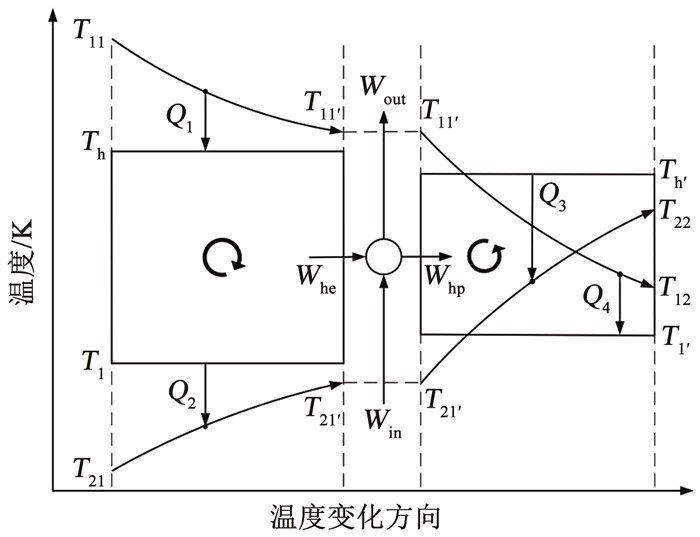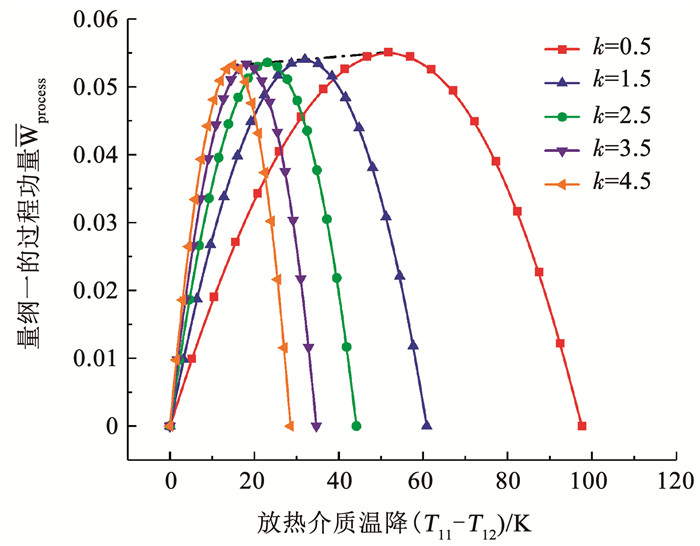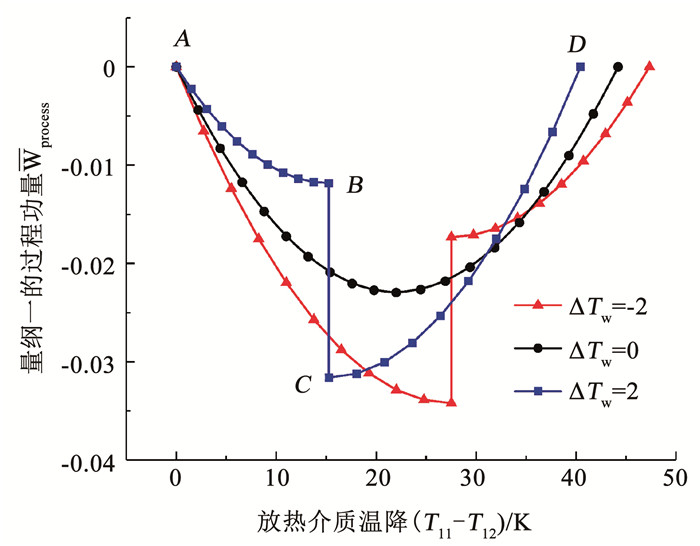 驱热力过程理论模型的热力学分析
驱热力过程理论模型的热力学分析
2. 寒地城乡人居环境科学与技术工业和信息化部重点实验室(哈尔滨工业大学), 哈尔滨 150090
 驱热力过程的基本概念。通过分析热机循环区间与热泵循环区间过程功量之间的关系,对
驱热力过程的基本概念。通过分析热机循环区间与热泵循环区间过程功量之间的关系,对 驱热力过程进行分类,并通过输出功量占比进行定量分析。构建并求解了顺流型和逆流型
驱热力过程进行分类,并通过输出功量占比进行定量分析。构建并求解了顺流型和逆流型 驱热力过程函数。分析了不同类型
驱热力过程函数。分析了不同类型 驱热力过程在理想条件下的热力特性与性能极限。研究结果表明:顺流型
驱热力过程在理想条件下的热力特性与性能极限。研究结果表明:顺流型 驱热力过程的最大过程功量大于逆流型,且放热介质与吸热介质间的温度交叉现象更为明显。吸热介质等效温升可用于判断
驱热力过程的最大过程功量大于逆流型,且放热介质与吸热介质间的温度交叉现象更为明显。吸热介质等效温升可用于判断 驱热力过程类型,其最大值表征了输出功量极限。实际系统的评价研究指出,串联型联合循环的总换热量是基本型ORC的1.97倍,更适用于同时具有热电需求的场合。但其净输出功效率(6.55%)、
驱热力过程类型,其最大值表征了输出功量极限。实际系统的评价研究指出,串联型联合循环的总换热量是基本型ORC的1.97倍,更适用于同时具有热电需求的场合。但其净输出功效率(6.55%)、 效率(26.61%)、热力完善度(36.38%)均显著低于基本型有机朗肯循环。双热源联合循环实际系统的热力性能提高方法值得研究。本研究可为不同类型两介质热功转换系统的热力性能极限与评价提供理论指导。
效率(26.61%)、热力完善度(36.38%)均显著低于基本型有机朗肯循环。双热源联合循环实际系统的热力性能提高方法值得研究。本研究可为不同类型两介质热功转换系统的热力性能极限与评价提供理论指导。 驱热力过程 两介质热功转换系统 热力学分析 过程功量 热力性能极限
驱热力过程 两介质热功转换系统 热力学分析 过程功量 热力性能极限 2. Key Laboratory of Cold Region Urban and Rural Human Settlement Environment Science and Technology (Harbin Institute of Technology), Ministry of Industry and Information Technology, Harbin 150090, China
在热机循环和热泵循环基础上构建的联合循环,具有热源利用效率高、输出能力强、能量输出形式多样等诸多优点[1]。一般而言, 联合循环中的热机子循环部分负责功量输出,热泵子循环部分则是在
以往研究多采用经典热力学和有限时间热力学方法,将上述复杂热力系统简化为多热源的理想热力学模型[8-10]。然而,由于热源条件、系统结构、输出形式均不相同,导致不同类型联合循环的热力性能无法对比;关于联合循环热力性能极限的理论研究也十分有限。以张世钢等[11]提出的吸收式大温差换热技术为例,该系统具有两热源特点(热网一次水和热网二次水),并能够让一次水出口温度大幅低于二次水进口温度,实现大温差换热。这在宏观上已经突破了传统温驱换热过程的极限换热情况。研究人员[12-15]提出了两介质换热系统的广义换热过程概念,揭示了两介质换热系统的能量转换机理、热力性能极限、大温差换热过程的判定依据与实际大温差换热系统的构建原则。然而,该理论模型的基本假设之一是热机循环的输出功量与热泵循环的输入功量完全相等,这显然不适用于研究热电联产系统、功冷联供系统等其他形式的联合循环。
本文以两介质热功转换系统为研究对象,提出




本文将具有以下特点的系统称为两介质热功转换系统:1)系统内部包括一个吸热介质和一个放热介质(包括源和汇)、换热设备以及热功转换设备;2)吸热介质与放热介质之间存在能量交换(热量、功量),但不存在质量交换;3)系统与外界之间可以存在能量交换(热量、功量),但不存在质量交换。
对于理想两介质热功转换系统而言,忽略系统内的一切不可逆损失,所有热力过程均为可逆过程,即系统中不存在不可逆因素。理想两介质热功转换系统是本文的研究对象,其特点是包含了两个有限热容的热源。






1) 放热介质的高温段设置若干可逆热机循环,并将这个区域称为热机循环区间。在放热介质低温段设置若干可逆热泵循环,并将这个区间称为热泵循环区间,如图 1、2所示。

|
图 1
连续顺流型 |

|
图 2
连续逆流型 |
2) 一部分热机循环输出的功量向系统外界输出;另一部分热机循环输出的功量驱动热泵循环。循环之间的能量传递在更多情况下是以

3) 热泵循环在外部

4) 在实际
5) 本文所定义的





1) 当热机循环区间输出的总功量超过热泵循环区间的输入功量时,本文定义这种热力过程为功量有富余的

2) 当热机循环区间输出的总功量不能满足热泵循环区间的功量需求时,本文定义这种热力过程为功量不足的

3) 当热机循环区间输出的总功量恰好与热泵循环区间所需的功量相等时,本文定义这种热力过程为功量相等的


对于以上3种分类,本文提出了输出功量占比这一量纲一的参数,用于定量分析

| $ \varphi=\frac{W_{\mathrm{net}}}{W_{\mathrm{he}}}=1-\frac{W_{\mathrm{hp}}}{W_{\mathrm{he}}} $ | (1) |
式中:φ为输出功量占比,Wnet为净输出功量,Whe为热机循环区间的总输出功量,Whp为热泵循环区间的总输入功量。
根据输出功量占比的不同取值,
1) 热机循环区间产生的功量全部用于对外界输出时,φ=1,对应于正余
2) 热机循环产生的功量一部分用于对外界输出,一部分用于驱动热泵循环,从而获取更多换热量时,φ∈(0, 1),对应于正余
3) 热机循环产生的功量全部用于驱动热泵循环,且外界输入功量为0时,φ=0,对应于等量
4) 热机循环产生的功量全部用于驱动热泵循环,且外界输入一部分功量同时驱动热泵循环,从而获取更大的换热量,此时φ∈(-∞, 0),对应于逆补
5) 热力过程中不再有热机循环区间,完全由外界输入功量驱动的热泵循环,此时φ=-∞,对应于逆补
除功量平衡分类方法外,还包括其他分类方法。根据两介质热功转换系统中的放热介质与吸热介质的不同流动形式,可将
当两介质的热容比随热功转换过程而变化时,本文称之为变热容比





本文着重研究连续顺流型和连续逆流型两种典型情况。单循环连续顺流型

|
图 3
单循环连续顺流型 |
| $ k=c_1 m_1 / c_2 m_2 $ | (2) |
式中:k为热容比,c1m1为放热介质热容,c2m2为吸热介质热容。
对于连续顺流型
| $ \mathrm{d} T_2 / \mathrm{d} T_1=-k \cdot T_2 / T_1 $ | (3) |
式中:T1为放热介质温度,T2为吸热介质温度。
假定式(3)的定解条件是给定放热介质进口温度T11和吸热介质进口温度T21,则有
| $ T_1^k \cdot T_2=T_{11}^k \cdot T_{21}=H_1 $ | (4) |
式中H1为积分常数。
本文规定,热机循环区间的输出功量与系统输出功量为正,热泵循环区间的输入功量与系统输入功量为负。则根据
| $ W_{\text {net }}=W_{\text {out }}-W_{\text {in }}=W_{\text {he }}-W_{\mathrm{hp}} $ | (5) |
| $ W_{\text {net }}=c_1 m_1\left(T_{11}-T_{12}\right)-c_2 m_2\left(T_{22}-T_{21}\right) $ | (6) |
式中:Wout为热机循环向外界输出功量,Win为热泵循环从外界获取功量,T12为放热介质出口温度,T22为吸热介质出口温度。
联立求解式(4)和式(6),则可得到放热介质和吸热介质之间的温度关系式:
| $ k \cdot T_{12}^{k+1}-\left(k \cdot T_{11}+T_{21}-\Delta T_\text{w}\right) \cdot T_{12}^k+T_{21} \cdot T_{11}^k=0 $ | (7) |
| $ \Delta T_{\mathrm{w}}=W_{\text {net }} /\left(c_2 m_2\right) $ | (8) |
式中ΔTw为吸热介质等效温升。
吸热介质等效温升的物理意义为:系统为了向外界输出净功量Wnet,而使吸热介质无法进一步升高的温度。在相同工况下,若将Wnet全部用于驱动理想条件下的热泵循环,则吸热介质出口温度可以进一步升高ΔTw。
式(7)确立了放热介质出口温度与放热介质进口温度、吸热介质进口温度、热容比、吸热介质等效温升之间的隐式函数关系,本文将该隐式函数关系定义为连续顺流型
| $ T_{12}=I\left(k, T_{11}, T_{21}, \Delta T_\text{w}\right) $ | (9) |
单循环连续逆流型

|
图 4
单循环连续逆流型 |
| $ T_1^{-k} \cdot T_2=T_{12}^{-k} \cdot T_{21}=H_2 $ | (10) |
式中H2为积分常数。
则放热介质与吸热介质之间的温度关系可以表达为
| $ k \cdot T_{11}^{1-k}-\left(k \cdot T_{12}-T_{21}+\Delta T_{\mathrm{w}}\right) \cdot T_{11}^{-k}-T_{21} \cdot T_{12}^{-k}=0 $ | (11) |
式(11)建立了连续逆流型

| $ T_1^{-k} \cdot T_2=\left[I\left(k, T_{11}, T_{21}, \Delta T_\text{w}\right)\right]^{-k} \cdot T_{21} $ | (12) |
本文与文献[15]中的可逆换热过程最大不同之处在于式(5),它可以对不同类型的两介质热功转换系统进行分析。采用牛顿-拉夫森单点迭代法即可对理想


连续顺流型








|
图 5
连续顺流型 |
在相同计算条件下,连续逆流型






|
图 6
连续逆流型 |
在
当放热介质出口温度与吸热介质出口温度相等时,此时热机循环区间内的总输出功量最大。本文定义该点温度为分界点温度T*,顺流型和逆流型
| $ T^*=T_{11}^{\frac{k}{k+1}} T_{21}^{\frac{1}{k+1}} $ | (13) |
| $ T^*=\left[I\left(k, T_{11}, T_{21}, \Delta T_\text{w}\right)\right]^{\frac{k}{k-1}} T_{21}^{\frac{1}{11-k}} $ | (14) |
对于k=1.0的特殊情况,逆流型



| $ \left\{\begin{array}{l} W_{\text {process }}=\int_{T_{11}}^{T^*}-c_1 m_1\left(\frac{T_1-T_2}{T_1}\right) \mathrm{d} T_1, \quad T_1 \in\left[T_{11}, T^*\right) \\ W_{\text {process }}=\int_{T^*}^{T_{12}}-c_1 m_1\left(\frac{T_1-T_2}{T_1}\right) \mathrm{d} T_1-W_{\text {net }}, T_1 \in\left[T^*, T_{12}\right] \end{array}\right. $ | (15) |
式中Wprocess为过程功量。
为了使分析更具普适性,本文定义了量纲一的过程功量,为

| $ \bar{W}_{\text {process }}=\frac{m_1 c_1 \cdot\left[\left(T_{11}-T_{12}\right)+\frac{H_1}{k}\left(\frac{1}{T_{11}^k}-\frac{1}{T_{12}^k}\right)\right]-W_{\text {net }}}{c_2 m_2\left(T_{22}-T_{21}\right)+W_{\text {net }}} $ | (16) |
| $ \bar{W}_{\text {process }}=\frac{m_1 c_1 \cdot\left[\left(T_{11}-T_{12}\right)+\frac{H_2}{k}\left(T_{12}^k-T_{11}^k\right)\right]-W_{\text {net }}}{c_2 m_2\left(T_{22}-T_{21}\right)+W_{\text {net }}} $ | (17) |
式中Wprocess为量纲一的过程功量。
在放热介质进口温度为383.00 K,吸热介质进口温度为303.00 K,净输出功量为零的条件下,图 7分析了顺流型


|
图 7
k对顺流型 |
在上述工况条件下,图 8分析了逆流型






|
图 8
k对逆流型 |
在放热介质进口温度为383.00 K,吸热介质进口温度为303.00 K,两介质热容比k=2.5的工况下,图 9分析了顺流型




|
图 9
ΔTw对顺流型 |
在上述工况条件下,图 10分析了逆流型







|
图 10
ΔTw对逆流型 |


受不可逆因素影响,实际系统所能达到的换热能力必然低于极限情况。换热完善度定义如下:放热介质与吸热介质进口参数相同,且输出功量占比相同的条件下,实际热力过程与理想
| $ \eta_{\mathrm{h}}=\frac{Q_{\text {real }}}{Q_{\text {iep }}}=\frac{T_{11}-T_{12 \text {, real }}}{T_{11}-T_{12, \text { iep }}} $ | (18) |
式中:ηh为换热完善度,Qreal为实际热力过程最大换热量,Qiep为理想

吸热介质等效温升表征了热力过程的类型,也是衡量做功能力的重要指标。吸热介质等效温升比定义如下:在放热介质与吸热介质进口参数相同,且输出功量占比相同的条件下,实际热力过程与理想
| $ \eta_{\mathrm{w}}=\frac{\Delta T_{\mathrm{w}, \text { real }}}{\Delta T_{\mathrm{w}, \text { iep }}}=\frac{W_{\text {net, real }}}{W_{\text {net }, \text { iep }}} $ | (19) |
式中:ηw为吸热介质等效温升比,ΔTw,real、ΔTw,iep为实际热力过程和理想

在放热介质与吸热介质进口参数相同,且输出功量占比相同的条件下,实际热力过程净输出功量效率与理想
| $ \mu=\frac{\eta_{\text {net }, \text { real }}}{\eta_{\text {net }, \text { iep }}}=\frac{\eta_{\mathrm{w}}}{\eta_{\mathrm{h}}} $ | (20) |
式中:μ为热力完善度,ηnet,real、ηnet,iep分别为实际热力过程和理想
串联型联合循环[3]是在基本型ORC[20]的基础上,通过梯级利用热源热量并回收全部冷凝热用于供热,因而具有输出能力强、输出形式多样的优点,适用于同时有用热、用电需求的场合。表 1列出了包括放热介质压力P1、吸热介质压力P2、蒸发器过热度ΔTe、冷凝器过冷度ΔTc、换热器窄点温差ΔT、泵效率ηp、膨胀机效率ηt在内的对比工况主要参数。在表 1所述工况条件下,采用

| 表 1 对比工况参数表 Tab. 1 Comparison of working condition parameters |
由表 2分析可知,基本型ORC系统对外净输出功量为257 kW,略高于串联型联合循环的244 kW。由于串联型联合循环的实际总换热量是基本型ORC总换热量的1.97倍,使得串联型联合循环的净输出功量效率仅为6.55%,显著低于基本型ORC的13.61%。从热力学第二定律角度分析,基本型ORC的


| 表 2 基本型ORC与串联型联合循环热力性能对比 Tab. 2 Thermal performance comparison between basic ORC and series-type combined cycle |
分析结果表明,基本型ORC在净发电效率、

双热源联合循环实际系统热力性能的提高方法主要包括:1)高性能喷射器和膨胀机的优化设计;2)根据能量梯级利用原则构建多段联合循环系统,减少不可逆程度;3)在热机循环区间与热泵循环区间设置回热器等。
4 结论1) 在顺流型
2) 相同工况下,顺流型
3) 吸热介质等效温升可以用于判断
4) 尽管热电联产系统的综合输出能力和热源利用效率较优,但其热力完善度仅为36.38%,大幅偏离了理想
| [1] |
OLIVEIRA A C, AFONSO C, MATOS J, et al. A combined heat and power system for buildings driven by solar energy and gas[J]. Applied Thermal Engineering, 2002, 22(6): 587. DOI:10.1016/s1359-4311(01)00110-7 |
| [2] |
CHEN Heng, YAO Xianhua, LI Juan, et al. Thermodynamic analysis of a novel combined heat and power system incorporating a CO2 heat pump cycle for enhancing flexibility[J]. Applied Thermal Engineering, 2019, 161: 114160. DOI:10.1016/j.applthermaleng.2019.114160 |
| [3] |
ZHANG Chenghu, LIN Jiyou, TAN Yufei. A theoretical study on a novel combined organic Rankine cycle and ejector heat pump[J]. Energy, 2019, 176: 81. DOI:10.1016/j.energy.2019.03.190 |
| [4] |
CHEN Yi, HAN Wei, JIN Hongguang. Proposal and analysis of a novel heat-driven absorption-compression refrigeration system at low temperatures[J]. Applied Energy, 2017, 185: 2106. DOI:10.1016/j.apenergy.2015.12.009 |
| [5] |
LI Yan, FU Lin, ZHANG Shigang, et al. A new type of district heating method with co-generation based on absorption heat exchange (co-ah cycle)[J]. Energy Conversion and Management, 2011, 52(2): 1200. DOI:10.1016/j.enconman.2010.09.015 |
| [6] |
RASHIDI J, YOO C. A novel Kalina power-cooling cycle with an ejector absorption refrigeration cycle: Thermodynamic modelling and pinch analysis[J]. Energy Conversion and Management, 2018, 162: 225. DOI:10.1016/j.enconman.2018.02.040 |
| [7] |
MOHAMMADI A, MEHRPOOYA M. Energy and exergy analyses of a combined desalination and CCHP system driven by geothermal energy[J]. Applied Thermal Engineering, 2017, 116: 685. DOI:10.1016/j.applthermaleng.2017.01.114 |
| [8] |
FEIDT M. Evolution of thermodynamic modelling for three and four heat reservoirs reverse cycle machines: A review and new trends[J]. International Journal of Refrigeration, 2013, 36(1): 8. DOI:10.1016/j.ijrefrig.2012.08.010 |
| [9] |
BAUTISTA O, MÉNDEZ F, CERVANTES J G. An endoreversible three heat source refrigerator with finite heat capacities[J]. Energy Conversion and Management, 2003, 44(9): 1433. DOI:10.1016/S0196-8904(02)00141-3 |
| [10] |
PARK H, KIM M S. Performance analysis of sequential Carnot cycles with finite heat sources and heat sinks and its application in organic Rankine cycles[J]. Energy, 2016, 99: 1. DOI:10.1016/j.energy.2016.01.019 |
| [11] |
张世钢, 付林, 李永红, 等. 吸收式换热过程及设备[J]. 暖通空调, 2015, 45(9): 85. ZHANG Shigang, FU Lin, LI Yonghong, et al. Process and equipment based on absorption heat exchange[J]. Journal of HV&AC, 2015, 45(9): 85. |
| [12] |
ZHANG Chenghu, LI Yaping. Concepts of reversible heat exchange process and limitation analysis on heat exchange process in isolated system[J]. Applied Thermal Engineering, 2017, 127: 1095. DOI:10.1016/j.applthermaleng.2017.08.094 |
| [13] |
ZHANG Chenghu, LI Yaping. Thermodynamic analysis on theoretical models of cycle combined heat exchange process: The reversible heat exchange process[J]. Energy, 2017, 124: 565. DOI:10.1016/j.energy.2017.02.103 |
| [14] |
ZHANG Chenghu, LI Yaping. Thermodynamic performance of cycle combined large temperature drop heat exchange process: Theoretical models and advanced process[J]. Energy, 2018, 150: 1. DOI:10.1016/j.energy.2018.02.096 |
| [15] |
李亚平. 大温差换热系统能量转换机理与应用[D]. 哈尔滨: 哈尔滨工业大学, 2019 LI Yaping. Research and application of energy conversion mechanism in large-temperature-drop heat exchange system[D]. Harbin: Harbin Institute of Technology, 2019 |
| [16] |
谭羽非, 吴家正, 朱彤. 工程热力学[M]. 6版. 北京: 中国建筑工业出版社, 2016: 94. TAN Yufei, WU Jiazheng, ZHU Tong. Engineeringthermodynamics[M]. 6th ed. Beijing: China Architecture & Building Press, 2016: 94. |
| [17] |
ZHANG Chenghu, LIN Jiyou, TAN Yufei. Parametric study and working fluid selection of the parallel type organic Rankine cycle and ejector heat pump combined cycle[J]. Solar Energy, 2020, 205: 487. DOI:10.1016/j.solener.2020.05.099 |
| [18] |
廉雪丽. 补燃型溴化锂吸收式换热机组供热性能研究[D]. 哈尔滨: 哈尔滨工业大学, 2018 LIAN Xueli. Research on heating performance of gas-supplement lithium bromide absorption heat exchanger[D]. Harbin: Harbin Institute of Technology, 2018 |
| [19] |
崔天阳. 自驱动湿热烟气全热回收系统运行特性研究[D]. 哈尔滨: 哈尔滨工业大学, 2019 CUI Tianyang. Study on operation characteristic of self-driving wet-hot flue gas total heat recovery system[D]. Harbin: Harbin Institute of Technology, 2019 |
| [20] |
CHEN Guibing, AN Qingsong, WANG Yongzhen, et al. Performance prediction and working fluids selection for organic Rankine cycle under reduced temperature[J]. Applied Thermal Engineering, 2019, 153: 95. DOI:10.1016/j.applthermaleng.2019.02.011 |
 2022, Vol. 54
2022, Vol. 54


